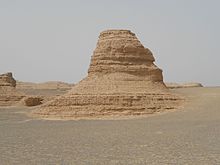Yardang
A Yardang (or Jardang , occasionally wind bump ) is a geo-morphological tabular form erosion in unconsolidated sediments (mostly in flat layered lacustrine sediments ).
The explorer Sven Hedin first named and described yardangs in 1903 when he was crossing the Chinese Lop Nor desert . He derived the word Yardang from the Uyghur word Yar , which can be translated as steep sandwall (English: ridge or steep bank ).
Emergence
Basics of the creation
Yardangs arise from the interaction of deflation , wind grinding ( corrosion ) and occasional water erosion. The final shape is formed by corrasion, that is, by wind grinding of the wind blowing steadily from one direction; the sand carried by the wind grinds the structures out of the ground. Initial forms of yardang formation are z. B. channels caused by runoff events, large dry cracks, but also tectonic dislocations and crevices. The grinding action of the wind, which is concentrated on the alleys, starts at these disturbances. Layered formations arise, which are caused by the changing resistance of the sediments.
These processes create a streamlined (teardrop-shaped) body with a wide windward and narrow leeward.
Form formation process
The steep windward side is formed by grain impact, updraft and countercurrent. The air is accelerated on the back and flank, the boundary layer is lifted at the widest point and the countercurrent begins underneath; eddies form in the leeward region when the currents meet. These erode the yardang from behind. Once the streamlined shape has been reached, the yardang is almost entirely deflated, as the boundary layer is no longer lifted.
Dimensions and shapes
The ratio of length to width is approx. 4: 1. Yardangs range in size from a few centimeters to several tens of meters (sometimes even larger).
Occurrence
Well-known occurrences on earth are the Yardang fields in Iran (these are called Shar Lut = desert cities), the Yardangs of the Lop Nor desert and the particularly pronounced Yardangs in the Sahara , which can be found between Hoggar , Aïr and Adrar des Iforas .
Although the planet Mars has a very thin atmosphere , Yardang structures have been detected in many regions of the planet that were able to form over a long period of time due to wind erosion. This provides information about the dynamics of the wind conditions on the surface of Mars.
For example, the European Mars Express spacecraft discovered yardangs next to table mountains in the Aeolis Mensae region and pronounced yardang structures near the Martian equator , west of the Tharsis region ; these are located in the area of Eumenides Dorsum (Greek: back of the furies ), which is characterized by volcanism . Another find of these structures formed by wind erosion is near the shield volcano Olympus Mons , the highest mountain in the solar system .
literature
- H. Besler: Geomorphology of the arid areas. Scientific book society. 1992.
- M. Halimov: Eight yardang types in central Asia. In: Journal of Geomorphology. NF 33, 1989, pp. 205-217.
- H. Reader (Ed.): Dictionary General Geography. 13th edition. Munich, Braunschweig 2005.
Web links
- SSE Multimedia Gallery Yardangs on Mars (English)
- Andrew S. Goudie: Mega-Yardangs: A Global Analysis . doi : 10.1111 / j.1749-8198.2006.00003.x
